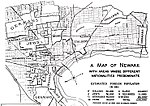Gateway Center (Newark)
Office buildings completed in 1972Prudential Financial buildingsSkyscraper office buildings in Newark, New Jersey

The Gateway Center is a commercial complex in Newark, New Jersey. Located downtown just west of Newark Penn Station between Raymond Boulevard and Market Street; McCarter Highway runs through the complex. Skyways and pedestrian malls interconnect all of the office towers, a Hilton Hotel, the train station, and the Newark Legal Center. Built in phases in the late 20th century the complex comprises some of the tallest buildings in the city, two designed by Victor Gruen Associates and two by Grad Associates.
Excerpt from the Wikipedia article Gateway Center (Newark) (License: CC BY-SA 3.0, Authors, Images).Gateway Center (Newark)
Penn Station Buses, Newark
Geographical coordinates (GPS) Address Phone number Website Nearby Places Show on map
Geographical coordinates (GPS)
| Latitude | Longitude |
|---|---|
| N 40.734722222222 ° | E -74.164166666667 ° |
Address
McDonald's
Penn Station Buses
07102 Newark
New Jersey, United States
Open on Google Maps








